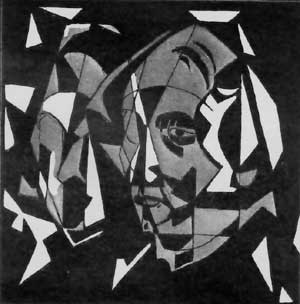Beer never claimed and never wished to be avant-garde. In February 1919, though, he is very much perceived as a pioneer by the then conservative Swedish art establishment. He takes part in a large group exhibition (The February Group) at the famous Stockholm gallery Liljewalchs, including important artists such as Bertil Bull Hedlund, Gösta Adrian Nilsson (GAN), Erik Detthow, Einar Forseth, Axel Fridell and Carl Kylberg. In parallel, the painter exhibits his personal production at a retrospective (1908-1918) held in another gallery, Nya Konstgalleriet on Strandvägen. Which only enhanced an apparent creative disruption: Nordic naturalism, impressionism, neo-impressionism, post-impressionism, cubism or expressionism… too many stages in too short a time, interpreted as contradictory. Where critics beforehand had hailed Dick Beer as one of the few Swedish impressionists faithful to French traditions, they are now completely baffled and react to these new almost abstract tendencies with suspicion and hostility. This would not have happened in Paris or Berlin, but Stockholm is another provincial story. What Beer displays are mostly large canvases in Cézanne-style cubism, showing a very personal touch. The fact that Beer is difficult to classify seems to have been the major cause of the scandal. He has met, become a friend of and worked with André Lhote, and it is probably under this influence that the Swede refines his sense of the monumental (see L’Escale painted by Lhote in 1913). We could name many other French cubists from this time, such as Henri Le Fauconnier (active until 1921) or Albert Gleizes, to make it clear that Dick Beer’s profession de foi is to be found not only in Paris but with the group Section d’or around Lhote, very different from the analytical and synthetic cubism experienced by Picasso or Braque. For most of these artists of the French cubist movement, this new representation approach represents only elements in artistic phases tending to expressionism, a more emotional art. At Liljewalchs, Beer’s paintings are mostly dark, with dominating ochre, wine-red or bottle-green. It melts together beautifully and the overall colour sensation conveyed is more warm than cold. This dramatic art appears to us distinct from that of his Swedish cubist colleagues of the time and Beer’s contribution to emotions is an overwhelming sensation of boyish mystery tour. A scandal it was. As so often in History of Art, we have difficulties to grasp today what the fuss was all about. Several portraits from this epoch are also remarkable in their forceful approach: Ruth, his wife ; Philippe de Rougemont, father to the abstract French painter Guy de Rougemont ; the portrait representing Mr Caldecott, nephew of Randolph Caldecott, the great British illustrator and friend of his father John Beer in London.

kontast-ljus-skuggor-figur, 1919
But Swedish critics did not recognize the importance of the Liljewalchs group exhibition in general and of Dick Beer’s work in particular (a couple of years later his female colleague Siri Derkert had a cubist exhibition and was as badly treated, having to wait 30 years before consecration!). On the contrary, several years after Picasso’s break-through on the continent, nobody in Sweden understood that it made perfectly sense to be naturalist and cubist at the same time (in other words: expressionist). Hence, Dr Ragnar Hoppe (the same who 23 years later gave Beer a deserved place in Swedish art history) executed the painter in public, through an article of extreme violence in the conservative daily Svenska Dagbladet. Dick Beer (more than his colleagues) is accused of pseudo-cubism, feeble intimism, pseudo-modernism, lack of courage and lack of ideas. His forms are too easy and cheap. He is judged to be ludicrous, insipid, and his art is full of awkwardness !
“Painting a canvas in an impressionist manner and then giving angles to its forms with a ruler, that’s not cubism, either it is a misunderstanding or it is humbug, in either case it is meaningless. But Beer is not even consistent in treating such form. That we may remark in the big Circus canvas, where some figures in the background have nothing to do with those in the foreground”
(Continued)